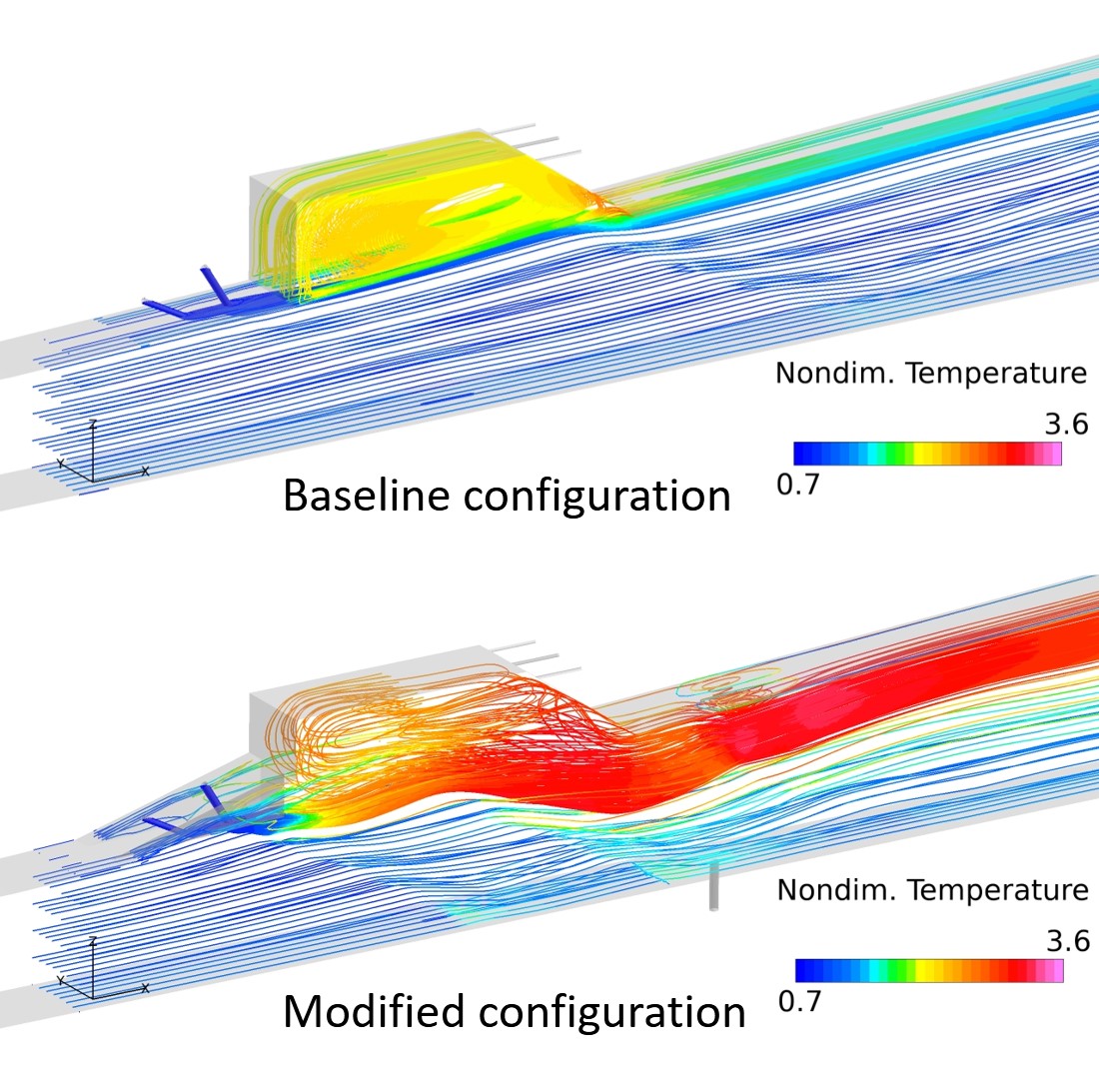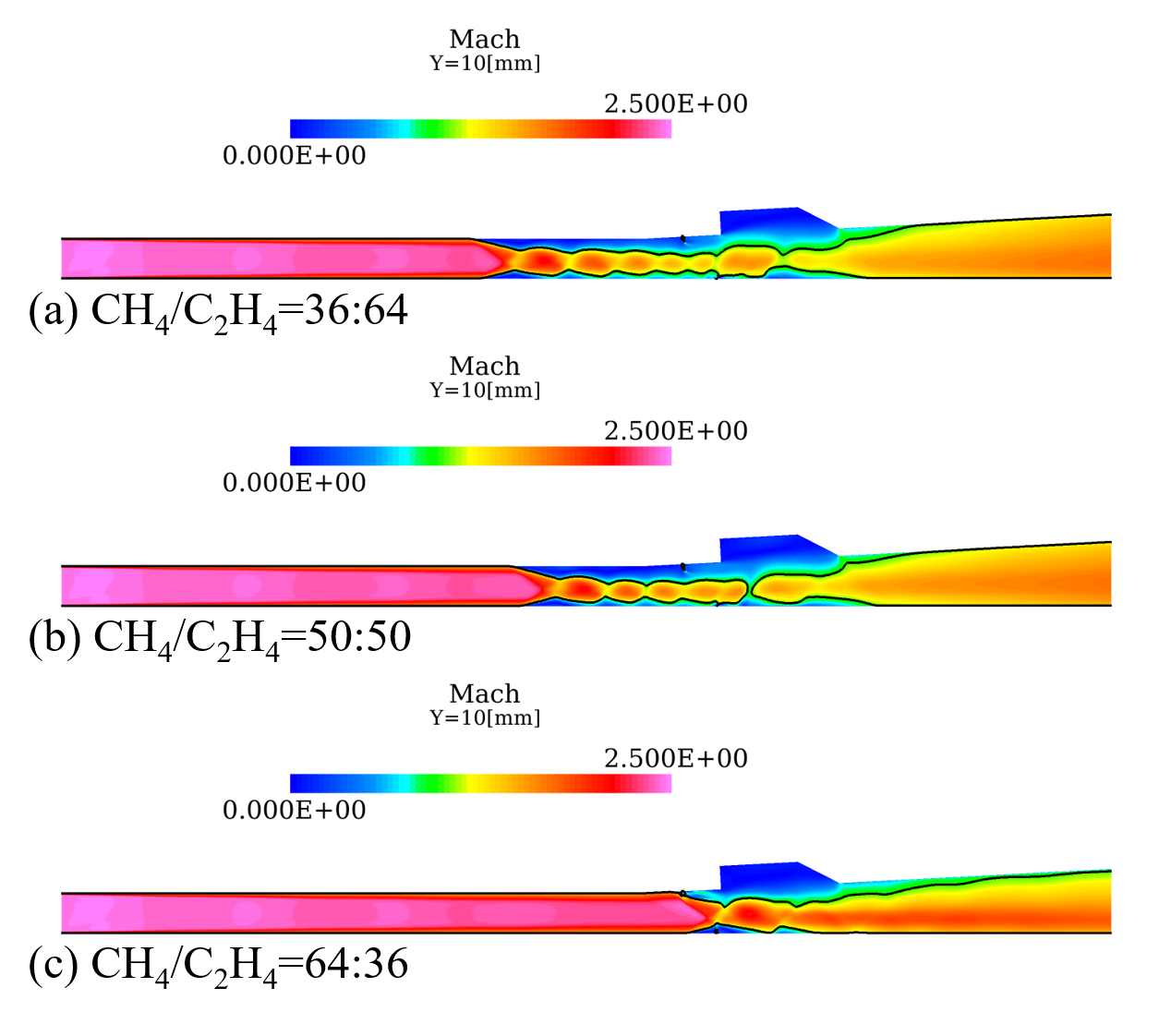Study on Future Space Transportation System using Air-breathing Engines
JAXA Supercomputer System Annual Report April 2020-March 2021
Report Number: R20EG3205
Subject Category: Research and Development
- Responsible Representative: Kouichi Okita, Director, Research and Development Directorate, Research Unit IV
- Contact Information: Masatoshi Kodera(kodera.masatoshi@jaxa.jp)
- Members: Masahiro Takahashi, Masatoshi Kodera, Masaaki Fukui, Toshihiko Munakata, Sadatake Tomioka, Hidemi Takahashi, Taku Inoue, Mizuki Fujiwara, Tatsushi Isono
Abstract
Recently, reusable rockets have been being studied to reduce the cost of space transportation systems significantly. However, in order to extend the structural lifetime, it is necessary to operate them with relatively low engine power, leading to a decrease in launch capability. Therefore, air-breathing engines such as scramjets and rocket/scram combined cycle engines are promising to compensate the drawback. By using air in the atmosphere as an oxidizer, it becomes highly efficient, and it can be expected to maintain and improve the launch capability even if it is reused. In this project, we will research and develop key technology for practical application of the engine.
Reference URL
N/A
Reasons and benefits of using JAXA Supercomputer System
The following points are raised as problems of engine design by ground experiments. 1) There are limits to reproducing various airflow conditions from takeoff to hypervelocity range. 2) Measured data is limited and complicated three-dimensional flow structure inside the engine can not be well identified. 3) Since the time and cost are limited, it is not easy to change the engine flow path configuration. Therefore, it is indispensable to utilize 3D CFD as a design tool, and a supercomputer is required for performing numerous CFD works efficiently.
Achievements of the Year
(1) A new algorithm for a flush air data sensing (FADS) system was developed to estimate flight data and attitude angles for a sharp-nosed hypersonic vehicle. The target condition is Mach 5.0 - 7.0 with angles of attack and sideslip within 6 degrees. The FADS system relates air data and pressures from surface-mounted pressure ports on the forebody of the vehicle to generate lookup tables that are used to estimate the air data. The estimation algorithm used by the designed FADS system is validated through numerical simulation, which was also used to generate lookup tables and wind tunnel experiments. Results indicated that the designed FADS system can estimate air data within the uncertainty of 6% for freestream conditions and within 0.7 degrees for the angles of attack and sideslip in the range of targeted flight conditions.
(2) A two-dimensional RANS analysis was conducted in a scramjet combustor with an injection of hydrogen parallel to an airstream behind a backward-facing step. This study evaluated the effects of the turbulent Schmidt number, turbulent Prandtl number, and chemical reaction model. The results of non-reaction test using inert gas as the mainstream showed a good agreement with the experiment. On the other hand, the results of reaction test using vitiated air, the ignition delay time was estimated to be shorter than in the experiment. The flame was stable downstream from the fuel injection as shown in Fig. 1.
(3) Numerical study to improve hydrocarbon-fueled scramjet combustors was conducted by CFD. Some of the promising configurations were further evaluated experimentally by conducting the combustion tests to confirm its effectiveness. Fig. 2 shows the comparison of the streamlines, whose color shows the local static temperature normalized by its value at the duct entrance, between the original configuration and the modified one. By adding expansion ramps on both sides of the fuel injection holes aiming to entrain more air into a cavity flame-holder, higher combustion pressure was achieved than the original configuration. The combustion tests also confirmed the advantage of the modified configuration.
(4) Continuing from last year, we conducted a 3D RANS analysis of a supersonic combustor with a cavity using a methane / ethylene mixed fuel, and examined the effects of the mixture ratio on the combustion flow field. (Fig. 3)
(5) We conducted a cooperative research with Kyushu University on the optimization of scramjet engines to expand the high-speed operating range. This year we focused on the mixing performance of the combustor and optimized the shape of the fuel injector.
Fig.1(video): Temperature distribution of scramjet combustor by two-dimensional RANS combustion analysis

Fig.2: Comparison of streamlines in hydrocarbon-fueled scramjet combustors, color of streamlines shows local static temperature normalized by value at duct entrance, Top: baseline configuration, Bottom: modified configuration

Fig.3: Changes in Mach number distribution on a cross section 10 mm away from combustor symmetry plane due to methane / ethylene mixture ratio
Publications
- Peer-reviewed papers
Takahashi, H., Kodera, M., and Tani, K., "Flush Air Data Sensing System for a Sharp-Nosed Hypersonic Vehicle with Curved-Wedge Forebody," AIAA Journal, Vol. 58, No. 11, 2020, pp. 4819-4831.
- Non peer-reviewed papers
Fujiwara, M., "The effects of turbulence characteristics and chemical reaction models on numerial analysis of scramjet combustors", Keio University, 2021, graduation thesis.
Usage of JSS
Computational Information
- Process Parallelization Methods: MPI
- Thread Parallelization Methods: N/A
- Number of Processes: 32 - 180
- Elapsed Time per Case: 90 Hour(s)
Resources Used(JSS2)
Fraction of Usage in Total Resources*1(%): 1.16
Details
Please refer to System Configuration of JSS2 for the system configuration and major specifications of JSS2.
| System Name | Amount of Core Time(core x hours) | Fraction of Usage*2(%) |
|---|---|---|
| SORA-MA | 6,550,451.49 | 1.24 |
| SORA-PP | 95,912.07 | 0.75 |
| SORA-LM | 0.00 | 0.00 |
| SORA-TPP | 0.00 | 0.00 |
| File System Name | Storage Assigned(GiB) | Fraction of Usage*2(%) |
|---|---|---|
| /home | 200.81 | 0.18 |
| /data | 5,852.08 | 0.11 |
| /ltmp | 5,071.93 | 0.43 |
| Archiver Name | Storage Used(TiB) | Fraction of Usage*2(%) |
|---|---|---|
| J-SPACE | 3.37 | 0.11 |
*1: Fraction of Usage in Total Resources: Weighted average of three resource types (Computing, File System, and Archiver).
*2: Fraction of Usage:Percentage of usage relative to each resource used in one year.
Resources Used(JSS3)
Fraction of Usage in Total Resources*1(%): 0.13
Details
Please refer to System Configuration of JSS3 for the system configuration and major specifications of JSS3.
| System Name | Amount of Core Time(core x hours) | Fraction of Usage*2(%) |
|---|---|---|
| TOKI-SORA | 478,788.00 | 0.10 |
| TOKI-RURI | 46,236.16 | 0.26 |
| TOKI-TRURI | 0.00 | 0.00 |
| File System Name | Storage Assigned(GiB) | Fraction of Usage*2(%) |
|---|---|---|
| /home | 296.03 | 0.20 |
| /data | 10,508.77 | 0.18 |
| /ssd | 622.70 | 0.33 |
| Archiver Name | Storage Used(TiB) | Fraction of Usage*2(%) |
|---|---|---|
| J-SPACE | 3.37 | 0.11 |
*1: Fraction of Usage in Total Resources: Weighted average of three resource types (Computing, File System, and Archiver).
*2: Fraction of Usage:Percentage of usage relative to each resource used in one year.
JAXA Supercomputer System Annual Report April 2020-March 2021


